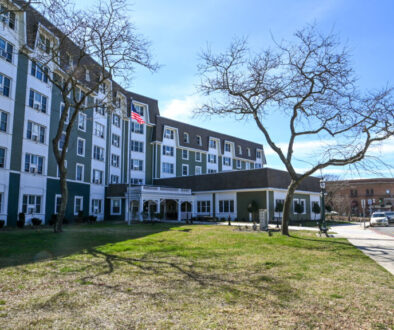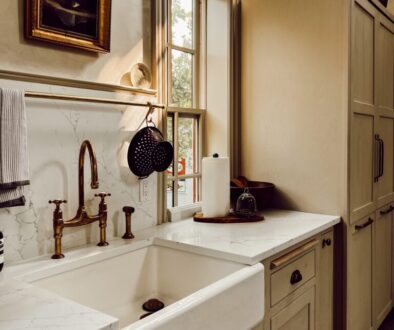An Unfair Rap

By far the most beautiful time for flowering trees and shrubs is the merry month of May. It is a time we look forward to all winter long. But if you’re a professional or even simply an avid gardener, you are so busy in May you have to consciously make yourself stop and take time to enjoy all the beauty. Cleaning, pruning, weeding, and mulching seem to consume your every waking moment—not to mention planting all those annuals!
Some people would argue it’s not worth it. Re-buying and replanting every year plus environmental concerns like all the water and peat moss they consume as well as having a heavy carbon footprint might lead you to abandon them altogether in favor of perennials only.
Don’t get me wrong, perennials are an important element in every design, but I think annuals sometimes get an unfair rap. There are tradeoffs in everything.
The Case for Annuals
If you decide to plant annuals, you work like a dog in May but then you are pretty much done until the end of November. Your plants will produce an unmatched profusion of colorful blossoms all summer long, unlike your favorite perennials that bloom for two to three weeks max.
Each year we get a do-over, which may be the best thing about annuals. You can easily change your color palette or style. For plant geeks like me, I get to go shopping every year and experiment with new varieties—more on that later. All of this comes with a relatively small investment depending, of course, on how many you buy.
Another benefit to annuals is that they require little to no maintenance. There is no dividing or transplanting, not to mention not having to worry about what to do with the plants you don’t have room for after you divide them. Many new varieties don’t even require deadheading. Hence, annuals are great for novice gardeners. There is little risk, minimal effort, and very little plant knowledge necessary.
They are also the answer to making new landscapes look finished. New plantings often look bare when the trees, shrubs, and perennials are young and therefore small. Filling in with annuals is a practical way to solve this problem. Each year as the larger specimens mature, you simply buy fewer of them.
Some environmental concerns surrounding annuals can be alleviated by adhering to the number one rule of landscape design—right plant, right place. Pay attention to drainage, amend the soil if necessary, and choose annuals that can take the sun if that is what you have. They will require a lot less supplemental water. Another plus for nature is that many annuals are rich sources of pollen and nectar and as such attract all kinds of pollinators. Your garden will be filled with bees, butterflies, and hummingbirds.
The bottom line is it’s all about balance. Every successful landscape should have trees, shrubs, perennials, and annuals all working together in harmony.
What is an annual anyway?
An annual is simply a plant that completes its entire life cycle in one year. What gets a little confusing is that there are plants we grow as annuals here in zone 8a that are actually perennials in warmer climates. There are also annuals that can survive more than a year here provided we have a mild winter. Some of them are even self-seeding, like alyssum. It takes some effort and patience, but you can transplant the young seedlings that appear almost as if by magic the following spring.
Many scientists have long been under the assumption that annuals evolved from perennials. But, according to Wikipedia, recent research challenges this notion, revealing instances where the reverse is true. It was discovered in 2008 that the inactivation of only two genes in one species of an annual plant leads to its conversion into a perennial. Intriguingly, models propose that transition rates from an annual to a perennial life cycle are twice as fast as the reverse transition.
Buying Annuals
My favorite way to purchase annuals is in flats. Unfortunately, it is becoming harder and harder to find them. Garden centers have figured out that people like immediate gratification and are willing to pay for it. So, instead of being able to purchase 32 little plants in a flat for $20 on average (or 62 ½ cents each), we can only buy small pots, each one containing three or four small plants for a cost of $4.99 ($1.25–$1.66) per plant. The plants are larger, but the truth is the smaller plants can be spread out to cover a larger area and will catch up to the bigger ones in a few weeks. Ah, the good ol’ days…
You can also grow annuals from seed by planting them in your own flats or sowing them directly in the ground.
Big box stores sell beautiful healthy plants and can save you money—if you buy them early. The plants they sell are perfect when they first arrive from the grower. The problem is they are often neglected and abused. Lack of water, too much heat, manhandling by customers, and overcrowded conditions all work together to weaken the plants. So, even if what you buy looks okay when you bring it home, it may not be as sturdy or strong as it looks. Most annuals will bounce back after wilting once or twice but each time they lose a little strength.
I prefer to buy from local garden centers like Secluded Acres, Cape Shore Gardens, Church’s, Cape Island Gardens, Garden Greenhouse, and Country Greenery. Purchasing plants online is never my first choice. I like to see exactly what I am buying. It is the only way to truly assess the health and overall appearance of your plants. If you are seeking an unusual variety, ask your local garden center. They can often order it for you.
Another word of caution: Some of the pre-made container plantings I’ve seen in recent years are combinations of plants that don’t like the same things. For example, cool season and heat loving annuals planted in the same pot. They look great early on, but by July only two of the three varieties may still be blooming. Be mindful of what you are buying.
Dos and Don’ts
The most important thing to consider when planting annuals is the soil. The right amount of water is crucial for their success. But it is the soil that regulates the retention of that water. Clay soil, especially when used in pots, can result in drowning. Sandy soils like ours don’t retain enough water. It drains right through. Loam (a balance of sand, silt, and clay) is what annuals want. You can transform your sandy soil by adding organic matter like humus and peat moss. If you are planting annuals in containers, I always recommend starting with a good quality potting soil meant specifically for that purpose. It will save you time and reward you in the end.
Be sure to add a continuous release fertilizer to the soil at the time of planting and again (by top dressing) in mid-summer.
Not all annuals require a lot of supplemental water. But they do require consistency. Most of them do not like to dry out—which means during the dog days of summer you have to pay careful attention—especially to your container plantings, which may require water twice a day. Add water-soluble fertilizer once per week for best results.
With the exception of transplanting baby seedlings, most annuals do not appreciate being transplanted. It’s not impossible, but it’s not recommended. In my experience, even if they survive the trauma they never seem to be the same again.
Challenges
Insects, too much rain or the lack thereof, extreme prolonged heat, and unwanted diners like rabbits can all result in a disappointing growing season. The best thing to do is to try to head some of these things off at the pass. Choose plants that are insect and disease resistant. Keep your gardens clean and weed free. Avoid overhead watering and water in the morning.
Bunnies are adorable but they can be terribly destructive. You can try deterrents but the best way to keep them from munching on your beautiful plants is to plant things they don’t like. They will simply go elsewhere unless they really have no choice. So, what don’t they like? Leaves that are jagged, prickly, or spiky; flowers that are toxic, like lantana; leaves and flowers with strong smells; plants with stems that are sappy and leaves that are fuzzy or leathery—like angel wings and dusty miller.
In addition, they tend to shy away from: ageratum, alyssum, browalia, calendula, cleome, coleus, cosmos, dahlia, geraniums, marigolds, nicotiana, Persian shield, salvia, snapdragons, strawflower, verbena, wax begonia, and zinnia. Keep in mind bunnies, like people, don’t all like the same foods. So, while begonias may be safe in your neighborhood, they might not be in some else’s.
As the season progresses, some annuals like impatiens and petunias can start to look a little spindly or leggy. Don’t be alarmed or concerned. Just muster up some courage, take a pair of shears and cut the plant back. Be fearless. Give it a nice long drink and maybe a little food and then be patient for a few weeks. You will be rewarded with a seemingly brand-new gorgeous specimen. By the way, don’t hesitate to purchase leggy plants from the garden center. They are likely to be a bargain.
Endless Choice
Globally, there are 369,000 species of flowering plants of which approximately 15 percent are annuals, according to a report by the Royal Botanic Gardens. If you do the math, that means there are over 20,000 flowering annual plants—of course not all are suited for backyard gardening! Still, we shouldn’t have to limit ourselves to marigolds, petunias, and vinca.
There is an annual for every situation and color palette. They can be used for borders and edging, as focal points, for massing or in containers. They vary in height from just a few inches to six feet tall. There are even annual vines that can be trained up a trellis which is a great way to add height to the back of a border.
Please note: Unlike trees, shrubs and perennials, the nomenclature used for an annual is sometimes its botanical name rather than its common name. For example, impatiens walleriana are almost always known as simply impatiens rather than their common names of touch-me-nots or busy lizzy. It is also important to note there are annuals and perennials that go by the same name.
With so many to choose from, it is hard to know where to begin. Let’s start by discussing the first annuals available in the garden centers each year.
Early Annuals
The first annuals to appear on the scene are the ones that can take the cold. But be careful. Most of them will peter out by mid-summer when temperatures rise. If you’re patient many of them will perk back up and start to perform again in late summer when things cool down a bit. The good news is that each year breeders introduce new varieties that seem to be more heat tolerant.
For the Foliage Only
There are even annuals that we grow for the foliage only—in a similar manner to hostas. Some of them don’t bloom at all! They come in many different colors including white, silver, pink, red, and every shade of green you can think of. Here are a few to get you started: angel wings, caladium, coleus, dichondra, dusty miller, licorice plant, Persian Shield, polka dot plant, and sweet potato vine.
Fragrance
An unfortunate effect of all the hybridizing that has given us prolific blossoms and improved disease resistance has been the loss of fragrance. The annuals we plant today are not nearly as sweet smelling as their ancestors were. If it is fragrance you love, there are a few left that have a light citrusy or sweetly floral aroma. You may even detect a few hints of chocolate. Be sure to position them near a door or window to catch their full effect. By the way, older varieties of these plants usually have more fragrance than new ones, but they can be difficult to procure and may require growing them from seed.
Happy Planting.
Impatiens (walleriana)
Impatiens are the most beloved annual of all time, accounting for 25 percent of the flower bedding market at the height of their popularity. These wildly popular shade-lovers were discovered by Claude Hope who had been sent to Costa Rica in the early to mid-1940s by the US Army to research a plant that could be useful in the treatment of malaria. After 23 years of breeding, Claude introduced the Elfin series of impatiens through the Pan American Seed Company which he founded. It took off with a shot, becoming the number one bedding plant in the U.S.—even surpassing marigolds and geraniums. All was wonderful until 2004 when downy mildew (which had started in Europe) arrived on our shores. Between 2011 and 2013 it all but eradicated America’s favorite annual.
Downy mildew is caused by the fungus Peronospora parasitica and can last in the soil up to five years, which is why impatiens nearly disappeared from garden centers everywhere. Relief finally came in 2019 when the Pan American Seed Company introduced a mildew resistant series of impatiens called Beacon. How fitting that they should come to the rescue on the 50th anniversary of the year in which they first introduced impatiens to the world. Simultaneously, Syngenta Flowers developed their own disease resistant series called Imara XDR. Both Beacon and Imara are now available in countless colors and mixes. Impatiens are back. Halleluiah!
New for 2024
Each year we talk about what’s new. The truth is there are very few truly “new” plants. Recently, while cleaning out my mother’s house (and garage) I unearthed her archive of old plant tags. She was an avid gardener and a bit of a pack rat. Anyway, it surprised me when I realized I am planting the very same plants she did 50 years ago—just new and improved varieties. There was something oddly comforting and pleasing to think that my gardens are similar to hers. As much as things change, they stay the same.
2024 promises to be an exciting year for annuals. Proven Winners is introducing 28 new show stoppers including five begonias, six calibrachoas, five Supertunias, two verbenas plus ten others. Incredible vigor, improved disease resistance and heat tolerance of early annuals are just a few things you can look forward to. Not to mention jaw dropping color—sunny yellows, bright reds, true whites, stunning corals and enchanting bicolors are everywhere. Here are some of my favorites:

Double Delight® Appleblossom Begonia
One of five new begonias from Proven Winners, Appleblossom produces an abundance of double white flowers with soft pink accents on cascading stems. The real surprise is its sweet citrus-like fragrance. It’s ideal for hanging baskets and a great solution for shade.

Superbells® Double Smitten Pink™ Calibrachoa
One of six new calibrachoas, Smitten Pink has delightful double-flowered light and rose pink bitone blossoms on cascading growth. These charming flowers are reminiscent of tiny little roses and will delight you all season long with no deadheading. Bees, butterflies, and hummingbirds.

Toucan® Scarlet (Imp) Canna
Scarlet red flowers top the lush green canopy of this mid-sized, vigorous, highly disease resistant canna lily that is as easy to grow as a petunia. Extremely heat and humidity tolerant without be especially water needy. Hummingbirds.

Safari® Dusk™ Jamesbrittenia
A relative of bacopa but with far greater heat and humidity tolerance, this jamesbrittenia has glitzy purple blooms with a gold eye on mounding to trailing stems. This surprising plant requires low water and little fertilizer. Set it and forget it.

Supertunia® Saffron Finch™ Petunia
One of five new Supertunias®, this sunny yellow stunner is reminiscent of Limoncello® but with more intense color. Its well-branched, rounded trailing habit make it perfect for containers but it can also be used as a groundcover. It is sure to make you smile as it blooms prolifically all season with no deadheading. Bees, butterflies, and hummingbirds.

Angel Wings Senecio
This head-turner will add great texture to containers and the landscape alike. It grows quickly to form a substantial upright clump and makes an outstanding focal point. Although it rarely blooms, its large silky silvery leaves are so soft you will want to pet them. It is heat, drought, and salt tolerant. Rabbit resistant.

Superbena® Pink Cashmere™ Verbena
Soft soothing shades of pastel pink flowers are clustered in huge umbels and rest atop deep green foliage. This extremely vigorous grower exhibits a mounded trailing habit and does not require deadheading. Bees and butterflies.

The 2024 Plant of the Year
Supertunia Vista® Jazzberry
How appropriate that in the middle of the new roaring ’20s the plant of the year should be named Jazzberry! This large, mounding spectacular plant puts on quite a show all summer long. It is usually so buried in flowers that the foliage is almost invisible. It is heat and drought tolerant and requires no deadheading.
Try pairing it with Safari® Dawn Jamesbrittenia, Supertunia® Hoopla™ Vivid Orchid™, Unplugged® Pink Salvia, Superbena® Pink Cashmere™, ColorBlaze® Newly Noir™ Coleus or Persian Shield. Butterflies and hummingbirds love it too.

Free annuals chart
Not sure which annuals are right for your garden? Download a free annuals chart to help you decide!



